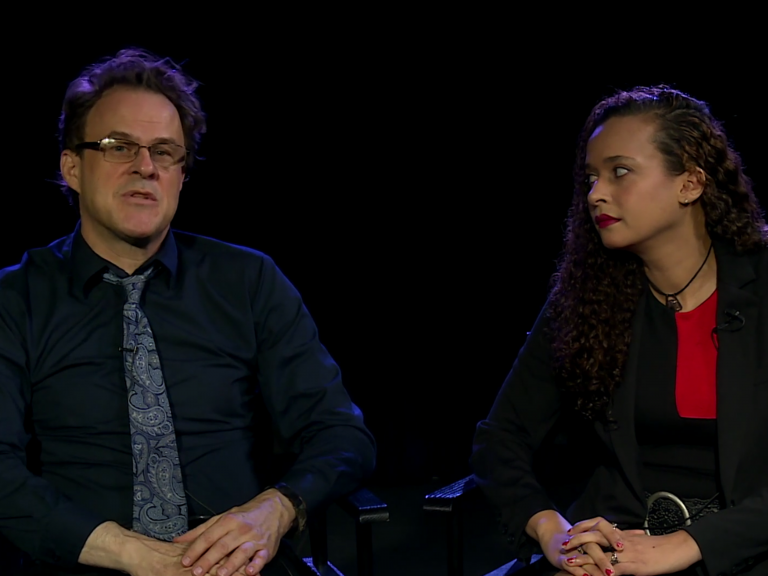By Ian Round
In 2013, the first two Black police officers ever to serve on Maryland’s Worcester County drug task force filed an EEOC complaint against the county for workplace discrimination, an act that would lead to the firing of the police chief in Pocomoke—a city in the county—and intervention from the U.S. Department of Justice’s Civil Rights Division.
This story, as well as that of the racial tension in Pocomoke—a small city where African Americans make up 50 percent of the population but only 20 percent of the city council—and the growing national momentum in favor of community policing, is the subject of a documentary being made by Taya Graham and Stephen Janis, investigative reporters at the nonprofit videojournalism outlet The Real News Network.
The two have been to Pocomoke, roughly two hours from Baltimore on Maryland’s eastern shore, about thirty times to report on the developing story over the last year and a half. They expect to complete the feature-length documentary by the end of 2017, and have begun a campaign on Indiegogo to help fund it. They’re calling it “The Friendliest Town on the Eastern Shore.”
The two officers who filed the discrimination complaint were members of the Pocomoke Police Department, which participated in the Worcester County drug task force. After they filed their complaint, Pocomoke Police Chief Kelvin Sewell, himself Black, felt pressure to fire them. Sewell, who had moved to Pocomoke in 2011 after working for the Baltimore Police Department since 1989, had been an effective chief, instituting a version of community policing and overseeing a reduction in crime. He did not fire the two officers, but filed a discrimination lawsuit of his own against the Pocomoke Police Department. In July 2015, Sewell himself was fired.
“For me this story in this small town is a microcosm of all we’re debating,” Janis said in a telephone interview about the project. “It’s about a community finding its voice.”
The documentary’s Indiegogo page, which includes a “pitch” (press play above to view) and many of the video reports Graham and Janis had previously produced, states, “This is a story with many layers that requires careful dissection. It embodies all the conflicts that define policing today. The narrative illustrates how racial mistrust and continuing discrimination can tear apart tight-knit communities. And most importantly, it documents how a population of African American residents embarked on a new era of political engagement and activism.”
Janis, who published a book on policing in Baltimore with Sewell in 2011, believes Sewell’s race—he was the first black police chief in Pocomoke—played a key part in his termination, and that this was especially shameful given Sewell’s record during his four years in Pocomoke. Janis said Sewell became disillusioned while working in the Baltimore Police Department homicide unit, and moved to Pocomoke determined to implement a different type of policing.
According to Janis, “[Sewell] Parked his car and walked around, and told his officers to do the same. Crime dropped precipitously.”
Janis added that this “version of community policing” is important because police departments “underestimate the importance of the lines of communication between police and the Black community. You can’t have policing without considering race.”
Janis said Sewell was particularly proud that there were no homicides in Pocomoke during his tenure; he said the city of about 4,000 averaged two or three each year, and that there have been five this year.
Graham and Janis will present the story against the backdrop of the Baltimore uprising and as part of the national conversation about policing and race. Janis thinks the story will tell itself, more or less.
“I think there are several layers to the story, and there’s a natural timeline,” Janis said. “There’s how he was fired, how the town reacted to it, background, and the conflict over the charges, which came to a head in the Worcester County Courthouse.”
Janis does not care about making the best-looking documentary. He said Graham and him will emphasize Pocomoke’s landscape and use medium-length shots from interviews that they have produced as short videos.
“Part of the interesting thing is we’ve shot a lot of video reportage, which is not necessarily how a lot of documentaries are shot,” he said. “So aesthetically, that immediacy, I hope, will translate well and make you feel like you’re there. The most polished piece of work is less important than the immediacy.”
This is Janis’s third documentary. His first, called “How Poverty Works,” was released last year. His second is about the decline in global investigative reporting, and he said it will be released in January.
This story was originally published by OnBcgkrnd.com, on Dec. 19, 2016.

